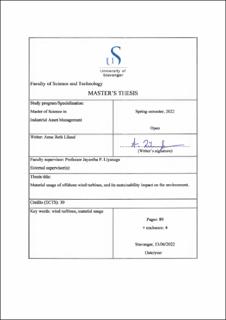| dc.description.abstract | As the world is working towards a greener energy environment, we see that more and more companies are changing their course to meet the green shift. Our future jobs will try to move more away from oil and fossil fuels, and rather focus on greener energy.
The author of this master’s thesis finds the new renewable energy focus very interesting and has therefore chosen to look at renewable energy within wind turbines during her master’s studies. In the search of a master’s thesis related to wind energy, Equinor was contacted, as it is well known that Equinor is a company focusing on wind energy. Equinor provided a thesis where they wanted to have a look at the production of wind turbines in their projects. They mainly wanted to have a look at the resources and raw materials used in the production of the wind turbines to map the wind turbines’ sustainability, but also the environmental and human consequences of the production.
In this master’s thesis it has been looked at the production of the Hywind Tampen wind turbines delivered to Equinor in accordance with the company’s energy shift and commitment to renewable energy (REN). The thesis is going into details of the materials used to produce one wind turbine, where information has been given by Siemens Gamesa Renewable Energy (SGRE) who is the vendor of the wind turbines for Equinor’s Hywind Tampen project. The materials have been broken down, as much as possible, to the natural raw materials. This has been done to be able to analyse how much of the Earth’s resources are used to produce the renewable energy, which again has been compared to the yearly production of the raw material. This master’s thesis is trying to give an answer to how sustainable the wind energy production is and how the wind turbine production affecting the environment in terms of the resources that are being used. Saying that something is sustainable means that the resource is being replenished at roughly the same rate as it is being used.
The thesis’s building structure starts with an introduction to the energy supply today, and the scope and objectives. The master’s thesis got 3 objectives:
• Looking at how much of natural raw materials that are used in the production.
• Looking at the environmental impact of producing and using the raw materials.
• Then provide improvements and recommendations.
The thesis proceeds with some literature overview related to wind energy in general, wind turbine construction and how the technology works, and the materials used when building a wind turbine.
In chapter 3 the author introduces Equinor as a company including a short introduction to its wind energy history and a brief overview of company’s wind farm projects, both in operation and under construction/in planning face.
The theses then analysis the Hywind Tampen project in chapter 4 with details about the materials used, the world’s annual production of the raw materials, how much reserves are estimated left in the world, and the environmental impact of the usage, before the master’s thesis rounds off with potential improvements and other recommendations in chapter 5, and discussion and conclusion in chapter 6.
When writing this master’s thesis, the author started out with gathering general information about energy, wind energy, wind turbines, and some background information about Equinor. The vendor for the Hywind Tampen wind turbines, SGRE, were contacted to get information about the materials used in the production of their wind turbines. After that, hours were spent to get into details of the materials used, so that the author was left with raw materials. In this process a lot of time was spent to find companies producing some of the materials used, and then to send out e-mails to ask for the material’s raw components. Then calculations were done to get into the details of the raw materials and creating tables with a good overview. Literature was searched for and read to get an insight in the environmental consequences of the usage and production of the raw materials, before recommendation, improvements, discussion, and conclusion was given based on the findings from the master’s thesis. The main result of this thesis project is to establish the amount of Earthly resources used to produce wind turbines, and then conclude on its sustainability based on that. | |
